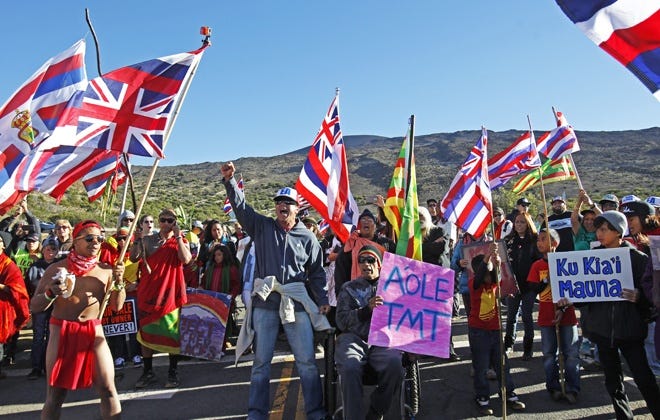
Indigenous people are in the streets protesting. Police are trying to curtail the protests to allow construction of infrastructure on sacred land. People are being arrested and groups like the ACLU are concerned about the safety of protestors.
Sound familiar?
No I’m not talking about the Dakota Access Pipeline (DAPL), but to think so would be an honest mistake. After all, the parallels between the movement to stop the DAPL and the one to halt construction of the Thirty Meter Telescope (TMT) on top of Mauna Kea are eerily similar.
Before getting into the striking similarities between the two indigenous-led movements and the common colonial thread between them, let’s break down what is happening on Hawaii’s biggest island today and why it is so important to Native Hawaiian culture.
Mauna Kea is a dormant volcano on the Island of Hawaii. Measured from it’s base below sea level, it is the world’s tallest mountain. According to Native Hawaiian tradition, it is the birthplace of Hawaii and the Hawaiian people. It is the home of numerous Hawaiian gods and goddesses, as well as the location of many sacred sites such as burials and altars.
For that reason, Native Hawaiians are fiercely resistant to construction desecrating their sacred land. Sadly, their concerns have already been disregarded countless times in the past as Mauna Kea already has 13 telescopes on it. They were all met with community opposition and lawsuits over environmental and cultural concerns. Many are not even in use anymore, demonstrating the waste that already exists there.
Back in 2015, protectors (as many prefer to be called over protestors) blocked construction of the TMT by camping out and blocking roads long enough for the Hawaii Supreme Court to block construction.
Since then the case has made its way through local courts and building permits have been reissued, with Hawaiian Gov. David Ige announcing that construction will resume shortly. He recently signed an emergency declaration giving police more authority to manage the situation.
While Gov. Ige said that he won’t call in additional National Guard troops and has never considered tear gassing protectors, his stance of siding with the development of the TMT and empowering police enforcement to push it through shows that he is fundamentally on the side of desecrating the sacred Mauna Kea — against the will of many Native Hawaiians.
All of this has inspired Native Hawaiians and their allies to once again resume protecting their sacred mountain. After 33 protectors were arrested last week, most of whom are well-respected Native Hawaiian elders, the amount of people gathered to block construction has surged to more than 2,000.
Elizabeth Warren, a 2020 Democratic presidential candidate, recently tweeted her opposition to the project. Actors Jason Mamoa and Dwayne “the Rock” Johnson, both with personal connections to Hawaii, have also been vocally supportive of Mauna Kea’s protectors.
— @ewarren
It remains to be seen how effective this resistance movement will be, but one thing is already readily apparent: American development is being prioritized over respect for indigenous culture again. This is a form of American colonialism that remains with us in the 21st century.
While Hawaii is no longer a colony of the United States, this telescope represents the continuation of colonial behavior.
The laws and court decisions allowing construction to go forward neglect indigenous culture and place greater importance on economic development and scientific achievement. Instead of giving Native Hawaiians greater input because of the cultural significance of Mauna Kea, their concerns have been disregarded. This is exactly what we saw with the DAPL water protectors, though with a much more violent response from law enforcement (so far at least) and no scientific benefits.

Rather than giving indigenous people proper input over what happens with their natural resources and cultural heritage sites, the government takes the side of development and sends police to put them in their place. It is this kind of disrespect for indigenous culture that is eerily reminiscent of our country’s colonial history.
In fact, it seems to be the modern version of that historical mindset. Like with racism, sexism and most other -isms, rather than disappearing, colonialism has changed with the times.
There is also an environmental aspect to the protectors' concerns. Mauna Kea is a conservation district which lies on top of Hawaii’s largest aquifer. The plans for the TMT call for two 5,000 gallon tanks underground, holding both human waste as well as other chemicals.
The environmental impact statement for the project basically says exactly what people are worried about, stating as follows:
“From a cumulative perspective, the impact of past and present actions on cultural, archaeological, and historic resources is substantial, significant, and adverse; these impacts would continue to be substantial, significant, and adverse with the consideration of the Project and other reasonably foreseeable future actions.”
As was the case with the DAPL, the TMT disregards input from indigenous people, putting their cultural heritage sites and local environment at risk. Rather than accommodating for the concerns of indigenous people, the response from the government in both situations has been to mobilize police to shut down acts of non-violent civil disobedience.
In 21st century America, that is the form colonialism against indigenous people often takes. If we want to make amends with our indigenous brothers and sisters for our colonial past, we need to start by making sure our current behavior isn’t reminiscent of that past.
Built using the Forest Map Wiki